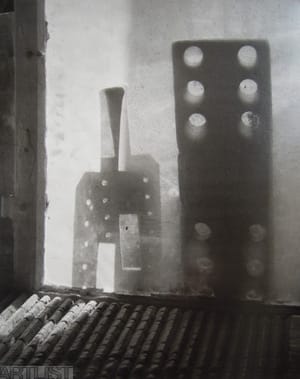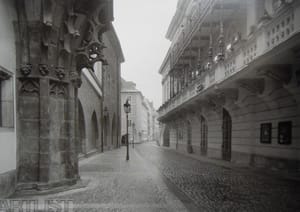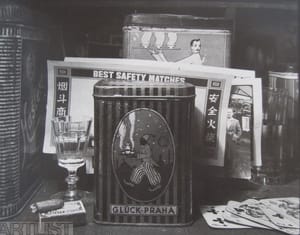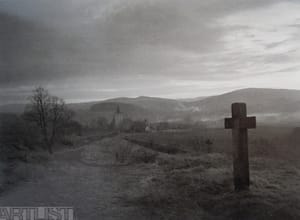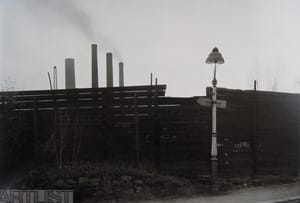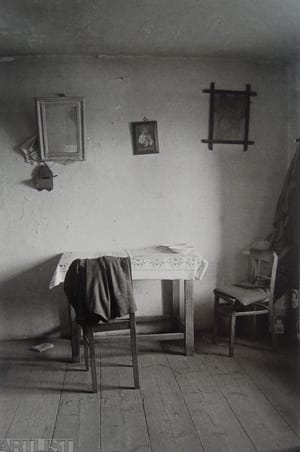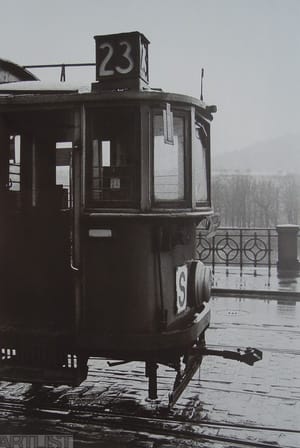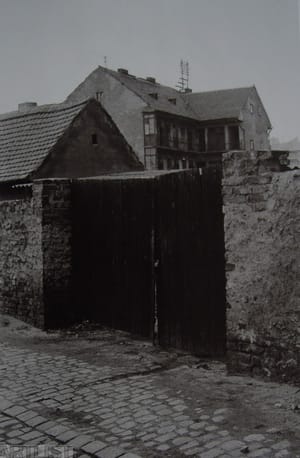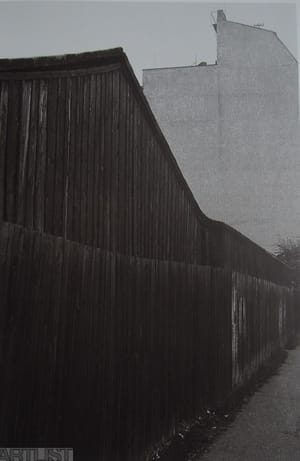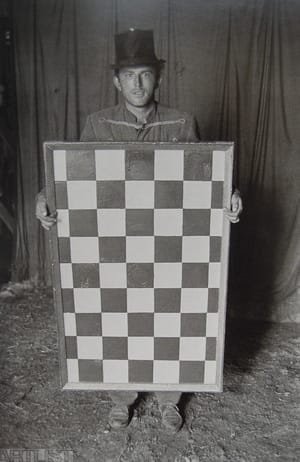- First Name
- Jan
- Surname
- Reich
- Born
- 1942
- Birth place
- Prague
- Died
- 2009
- Keywords
- CSU Library
- ↳ Find in the catalogue
About artist
Jan Reich is characteristically classified among classical Czech photographers, primarily with respect to using traditional analogue procedures and maintaining purely craft approach when processing photographs. His classicality is rooted in his relentless searching for something photogenic and in his strict use of black and white photography for the purpose of emphasizing the beauty and mystery that he witnessed in reality.
With the desire to preserve what is magical about the present, he sets out in the 1970s to Prague’s periphery quarters of Holešovice, Libeň and Radlice. From the cruelty of the Normalization period’s grey colour he pulls out, in his photographs, black railings, fences, rail ties and garages contrasting with the whiteness of uncovered inner building facades, snow or for Reich the omnipresent whitish fog. Reich photographed what he felt: “The 1970s were scary, absolute motionlessness prevailed. People used to go to the pub, compete in drinking, there was nothing else to do.” In spite of that, as he said himself, he did not want to capture the disintegration and entropy of industrial places, but, on the contrary preserve its charm.
His photographs of Prague from the 1970s are empty and strongly abstract. He is interested in black and white areas, diagonals, crossings and intersections of geometrical elements submerged in one another, just like in the cruelness of advertising signs. His pictures conforming in form to modernistic photography are completely without any people. Similarly empty, in an Atget way, are the insides of cottages that Reich photographed after his relocation to the Sedlčany region in the 1980s. Unlike Atget, however, his photographs are not motivated by doing documentation for state institutions, on the contrary Reich is searching for and captures places that he wants to protect from the Communist regime. Even people do not completely disappear from his interiors. They are not on the photographs but their presence is still distinguishable. There were not many times that he returned to real portraits, as he did in the 1950s, when, due to the political situation preventing him to study at his chosen secondary and later post-secondary schools, he set out to wander with a circus. The only exceptions include intimate portraits of his friends and his wife Jana.
For a long time Jan Reich pursued photography of landscapes. He preferred winter, melancholic, snowy, quite views of the country. His landscapes are often very romanticised and mysterious. They capture places connected with religion and in their sometimes almost dramatic position, they can remind of some paintings of pioneers of landscape painting in Bohemia such as Bedřich Pippenhagen or even older paintings of Dutch masters. For that matter, Reich was not too far off from old masters’ compositions to which he made references in his arranged still life photographs.
His intentions are most apparent when we compare his own work and the commission work in colour which he did during the 1980s to earn extra money as the photographer for Pressfoto – publications with domestic focus. In his personal selection of landscapes Reich often turns to the picturesque and historically administered, unlike the deserted and dying landscapes as we can see on photographs by Karel Kuklík from the 1960s and 1970s, for example. This deviation to patriotism in a time of personal and society-wide crisis in the 1990s, spans over to pious admiration of significant national places, which Reich visits and photographs. The outcome of this work is a publication called Bohemia. His photographs from Prague from the 1990s are, perhaps characteristically, released of the previous magic and start to be truly, not only formally, empty.
In his last collection that Reich intensely devoted himself to, it was as if he was knowingly returning to the Czech Sudek classic and references to modernism, which silently stretched through his previous work. His still lifes from the years 2004–2008 simultaneously owe much to the rayograph technique, the illusion of which he achieved by the composition of ordinary house objects behind an old removed window.
- Author of the annotation
- Tereza Hrušková
- Published
- 2016
CV
Studies:
1965–1970
Academy of Performing Arts, Prague
Exhibitions
- Solo exhibitions
-
2013
Jan Reich: Mizející Praha, Galerie Portheimka, Praha 5
Jan Reich, Galerie U Betlémské kaple, Praha
2012
Jan Reich: Fotografie, Pražský hrad, Starý královský palác, Tereziánské křídlo, Praha
2007
Jan Reich: Mizející Praha, Muzeum hlavního města Prahy, Praha 1
2006
Jan Reich: Hors nos murs, Centre tchèque Paris (České centrum Paříž), Paříž (Paris)
2001
Jan Reich: Dům v krajině, Pražský dům fotografie (2000-2002), Praha 1
2000
Jan Reich: Mizející Praha, Tschechisches Zentrum (České centrum) , Berlín (Berlin)
1996
Jan Reich: Mizející Praha ( 1971 - 1976 ), Dům umění města Brna, Brno
1995
Jan Reich: Fotografie, Dům umění v Opavě, Opava
Jan Reich: Dvě města, Galerie Štěpánská 35, Praha
1992
Jan Reich: Mizející Praha, Středočeské muzeum, Malá výstavní síň, Praha
1990
Jan Reich: Periferie, Malá galerie České spořitelny, Kladno
1981
Jan Reich: Fotografie 1964-1980, Staroměstská radnice, Praha
1977
Jan Reich: Fotografie 1967 - 1976, Malá výstavní síň, Liberec
Jan Reich: Periferie, Divadlo v Nerudovce, Praha
- Group exhibitions not included in ARTLIST.
-
2013
Otevřená kniha, DOX, Malá věž, Praha
2011-2012
V plném spektru. Fotografie 1900-1950 ze sbírky Moravské galerie v Brně, Pražákův palác, Brno
2010
Czeski Drzewak i jego gość - Czeska fotografia wielkiego formatu, Galeria Pusta, Katowice (Katowice)
2009
Tschechische Fotografie des 20. Jahrhunderts, Kunst- und Ausstellungshalle der Bundesrepublik Deutschland, Bonn
Jan Palach: 16. - 25.1. 1969, Pražský dům fotografie (Prague House of Photography, o.p.s - PHP), Praha 1
2008
Moderní a poválečné umění, současné umění, fotografie, Galerie 5. patro, Praha
2006
Karel Hynek Mácha (1810-1836) a současné umění, Galerie Vyšehrad (nad Libušinou lázní), Praha
Portfolia 1989-1996 z kolekcji Jiřego Hankego, Galeria Parter, Kłodzko
Český dřevák, Wortnerův dům Alšovy jihočeské galerie, České Budějovice
Jan Reich: Bohemia, Jindřich Štreit: Moravia, Piazza-Palace Berlaymont, Bruxelles
2004-2005
Český dřevák: Fotografie, Malá galerie České spořitelny, Kladno
2003
Reality Check, Galerie Rudolfinum, Praha 1
2002
Skupina 42 - II, Galerie Nový Svět, Praha
2001
Fotografie jako umění v Československu 1959 - 1968, Místodržitelský palác, Brno
1994
Czech and Slovak Photography from Between the Wars to the Present, Middlebury College Museum, Middlebury
Czech and Slovak Photography from Between the Wars to the Present, Boston Public Library, Boston
Czech and Slovak Photography from Between the Wars to the Present, Boston Atheneum, Boston
1993
Czech and Slovak Photography from Between the Wars to the Present, Fitchburg Art Museum, Fitchburg
1989
37 fotografů na Chmelnici, Junior klub Na chmelnici, Praha
1982-1983
Aktuální fotografie ze sbírek Moravské galerie v Brně, Kabinet užitého umění, Brno
1977
Mladí výtvarníci (Miroslav Čermák: Sklo, Jiří Dostál: Obrazy, Jaroslav Malina: Obrazy, Jiří Nepasický: Obrazy, Jan Reich: Fotografie, Vladimír Svoboda: Fotografie, Jan Vančura: Obrazy), Malá výstavní síň, Liberec
Soudobá výtvarná fotografie, oborová výstava, Galerie Jaroslava Fragnera, Praha
1969
Fotografie, Galerie Fronta, Praha 2
- Collections
-
Centre Georges Pompidou, Paříž (Paris)
Městská galerie, Brno (Brno-město)
The Museum of Fine Arts Houston, Houston
Uměleckoprůmyslové museum, Praha

